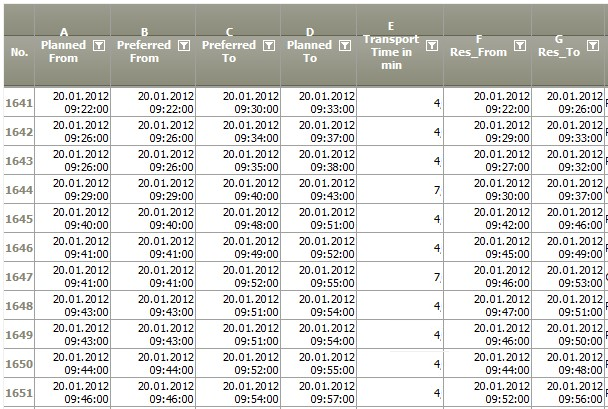Optimizer: Sequence Simple
This operator has been deprecated.
Summary
Optimizer: Sequence Simple
Getting Started | This operator allows to find an ideal time interval for a task or shift in a given possible and a given preferred time interval. This could help to find the optimal time interval for breaks or service tasks which are not too time critical.
| ||||||||||||||||||||||||||||||||
Input data | This is the data containing the task information. This data is provided by the parent data node or by the data node itself.
| ||||||||||||||||||||||||||||||||
Parameter with Shift Information | The first five settings are linked to another data node, which contains information about shift types, such as identifier and shift length (from/to).
| ||||||||||||||||||||||||||||||||
Other Parameters | The other parameters contain:
| ||||||||||||||||||||||||||||||||
Example | In this example from a hospital, patients should be transported from a place to another one. The times are normally given by the beginning or the end of a treatment, but have some flexibility at the end. So the optimizer calculated the ideal time period for these transports. | ||||||||||||||||||||||||||||||||
Attention | Pleases be aware that the Optimizer can only deal with a minimum interval of one minute. |
Configuration
Input settings of existing table
Name | Value | Opt. | Description | Example |
|---|---|---|---|---|
Identifier | System.Object | opt. | Which columns should be evaluated for the identifier? | - |
Scheduled (from) column | System.DateTime | - | Column containing the start (date+time) of the permitted period. | - |
Scheduled (to) column | System.DateTime | - | Column containing the end (date+time) of the permitted period. | - |
Preferred (from) column | System.DateTime | - | Column containing the start (date+time) of the preferred period. | - |
Preferred (to) column | System.DateTime | - | Column containing the end (date+time) of the preferred period. | - |
Ratio column | System.String | - | - | - |
Duration column | System.Double | - | Duration | - |
Settings
Name | Value | Opt. | Description | Example |
|---|---|---|---|---|
Node with shift data | System.Int32 | - | - | - |
Shift Identifier column(s) | System.String | opt. | - | - |
Shift (from) column | System.String | - | - | - |
Shift (to) column | System.String | - | - | - |
Column shift pers, number | System.String | - | - | - |
Weighting hours | System.Double | - | - | - |
Weighting continuously | System.Double | - | - | - |
Weighting peaks | System.Double | - | - | - |
Weighting shift | System.Double | - | - | - |
Weighting preferred | System.Double | - | - | - |
Optimization attempts | System.Int32 | - | - | - |
Want to learn more?
Troubleshooting
Nothing known up to now.

